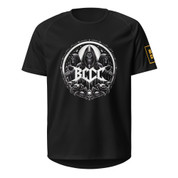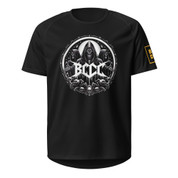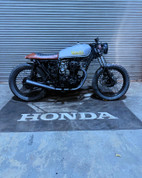 Loading... Please wait...
Loading... Please wait...- Home
- History
History
New Products
-
BCDC LOGO Jersey (no back) $25.00
History
Cafe Racers: The Timeless Reincarnation of Speed and Style
In the world of motorcycles, few styles evoke the same level of nostalgia, rebellion, and elegance as the iconic cafe racer. Born out of post-World War II England and continuously evolving through the decades, the cafe racer represents more than just a motorcycle style; it's a cultural phenomenon that celebrates speed, customization, and a distinct blend of form and function.
Origins and Evolution
The cafe racer's roots can be traced back to the 1960s in the United Kingdom. Following the war, a generation of young motorcyclists sought an escape from the austerity of the time. Their desire for speed and individuality led to the creation of stripped-down, light, and powerful bikes capable of achieving high speeds between cafés, hence the name "cafe racer." These enthusiasts sought to mimic the streamlined appearance of the grand prix racing motorcycles of the era, even on everyday street machines.
Initially, the cafe racer scene was characterized by modifying existing motorcycles, often British-made bikes like Triumph, Norton, and BSA. These modifications included removing excess weight, swapping out heavy parts, and fitting the bikes with low-mounted handlebars known as "clip-ons." The emphasis was on achieving a minimalist design that prioritized performance over comfort.
As the years went on, the cafe racer trend spread beyond the UK, influencing motorcycle culture worldwide. While the original cafe racers were often created through a mix of DIY craftsmanship and backyard mechanics, modern cafe racers can be found in various iterations, ranging from meticulously crafted custom builds to factory-produced motorcycles that pay homage to the style.
Key Features of Cafe Racers
The cafe racer style is characterized by a distinct set of features that set it apart from other motorcycle genres:
-
Minimalist Design: Cafe racers embrace minimalism in both aesthetics and functionality. Unnecessary components are stripped away, leaving only the essentials for a clean and streamlined look.
-
Low Handlebars: One of the defining features of cafe racers is the low, narrow handlebars, also known as clip-ons. This aggressive riding position contributes to aerodynamics and control at higher speeds.
-
Rearset Footpegs: The footpegs are positioned further back on the frame, forcing the rider into a more leaned-forward posture, which enhances aerodynamics and control during acceleration and cornering.
-
Single Seat: Cafe racers typically sport a solo seat, emphasizing the bike's solo riding nature. This design choice not only reduces weight but also contributes to the bike's sleek profile.
-
Distinctive Aesthetics: The cafe racer's design is often characterized by a teardrop-shaped fuel tank, minimalist fenders, and exposed mechanical components. This combination creates a raw and authentic appearance.
-
Customization: While modern manufacturers now offer factory cafe racer-style motorcycles, the heart of the movement lies in custom builds. Enthusiasts take pride in handcrafting unique machines that reflect their personal style and preferences.
The Cafe Racer Revival
In recent years, there has been a significant revival of interest in the cafe racer style. This resurgence can be attributed to several factors, including the timeless appeal of the design, the rise of the do-it-yourself (DIY) and maker culture, and a longing for authenticity in a world dominated by mass-produced products.
Modern cafe racer enthusiasts have access to a wide array of resources, from online forums and communities to specialized workshops and aftermarket parts suppliers. This accessibility has empowered a new generation of motorcycle enthusiasts to embark on their own cafe racer projects, infusing new life into a classic style.
Conclusion
The cafe racer is more than just a motorcycle style; it's a cultural movement that encapsulates the spirit of individuality, rebellion, and a love for speed. From its humble origins in the UK to its worldwide influence on motorcycle culture, the cafe racer continues to captivate the hearts of enthusiasts and riders alike. With its minimalist design, distinctive aesthetics, and emphasis on customization, the cafe racer remains a testament to the enduring appeal of blending style and performance on two wheels.





